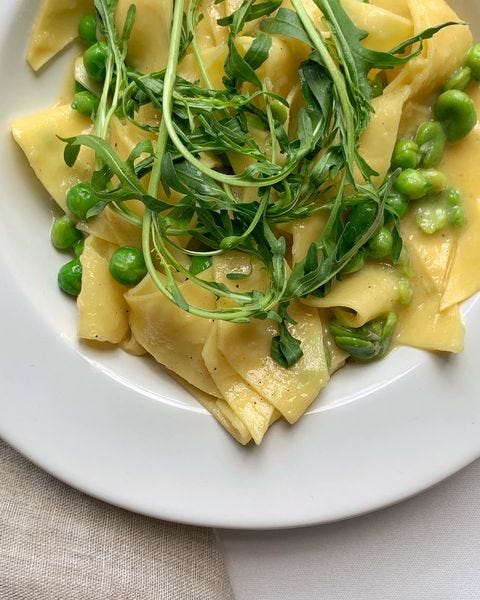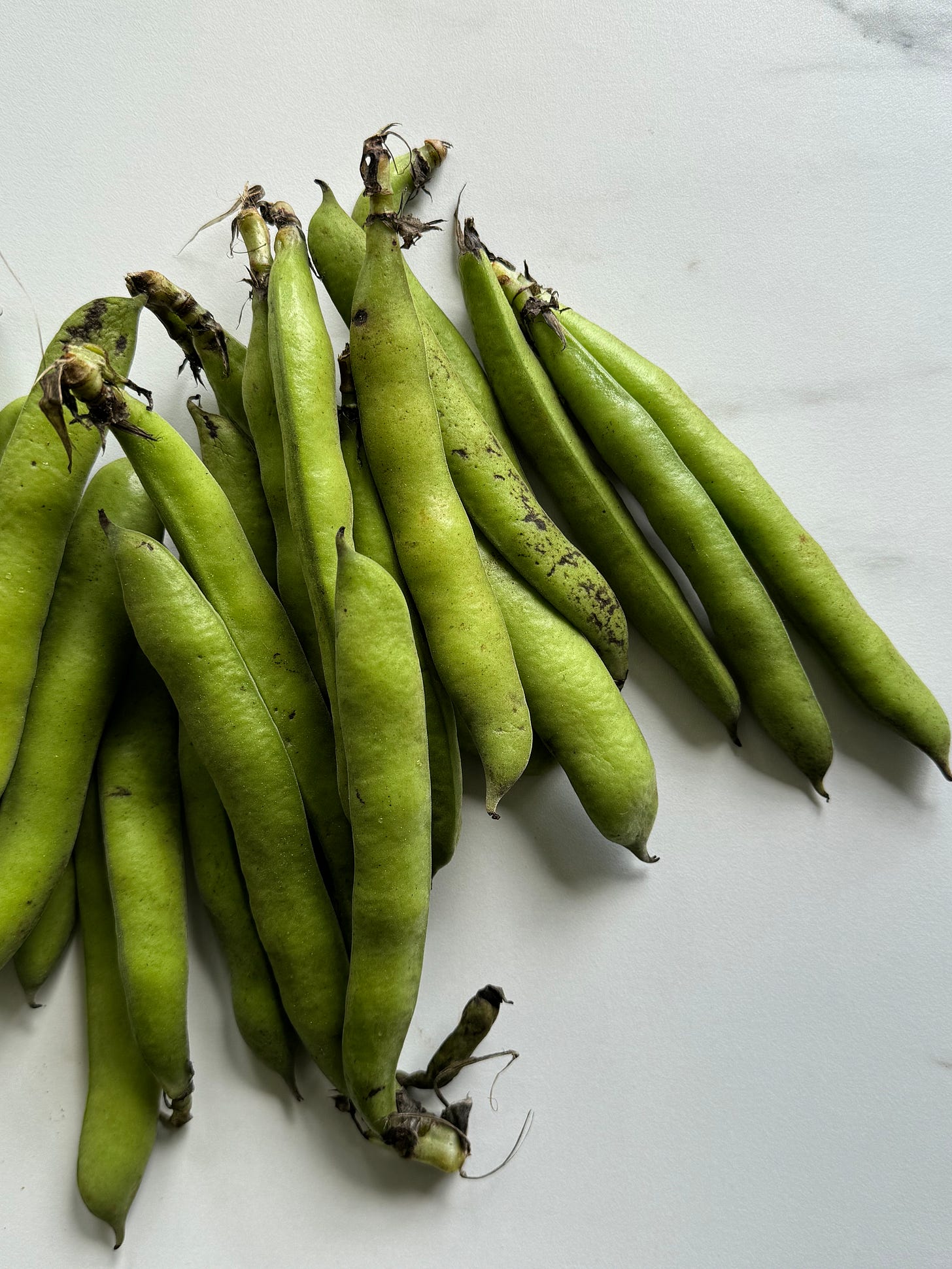👋+: Danish Bread Rolls & Fresh Fava Pea Soup
early summer toast toppings + dealing with cooking fatigue
Allô! 👋
Hello, and thank you for being here! Welcome (back) to the seasonal sundays section of the good food at home newsletter, where every week we take a closer peek at produce at its peak — with a short introduction, a recipe, and a (sometimes related) cooking Q&A. If you’re a new subscriber and would like to read the previous issues, you can click here to find them!
Happy Sunday (summer’s first)! I hope the weather’s been treating you well.
On today’s menu, we have an introduction to peas and broad beans, a sought-after recipe for Danish bread rolls, a simple recipe for the delightfully green pea and broad bean soup pictured above, and a chatty little Q&A to tackle the oh-so-relatable topic of cooking fatigue.
As always, I hope you enjoy the read.
— Simone
Although the estival season has only just officially begun, it seems that in recent weeks the days have either been unbearably hot, relentlessly moist, or some unseasonable combination of the two. (Here in Southeastern Norway, it’s mostly been thunderstorms, wind storms, and hail storms lately — not exactly typical June weather.)
Still, in spite of the increasingly extreme and unpredictable climate, expert growers have managed to continue the hard work of nurturing the produce they’ve been preparing for all year, and many (but not all) crops are managing to ripen unharmed and on time.
Depending on where you live, the summer solstice marks an agricultural turning point that either indicates the end of “cool-but-warm” weather crops like peas and broad beans (but also artichokes and tender greens), or their prolific beginning.
Either way, no matter where you are, early summer is the start of a busy period during which it becomes increasingly easy and alluring to enjoy an abundance of fresh produce — fruit, veg, cheeses, herbs — with, between, or on some quality pieces of bread.
BROAD BEANS & PEAS — TYPES & VARIETIES
Though the terms “broad bean” and “fava bean” are often used interchangeably* — and sometimes swapped with “horse bean” or “field bean” — the former pair generally refer to the larger, softer cultivars grown for human consumption, while the latter two typically designate smaller, harder, wilder cultivars which are typically (but not always) reserved for feeding animals or used as cover crops to keep the soil healthy in between plantings (they also make for excellent falafels).
As for peas, the three main types are English or garden (shelling) peas, Chinese or snow peas, and a cross between the two: (sugar) snap peas. Unlike shelling peas, snow peas and snap peas are almost always eaten whole, pod and all, and they also are tender enough to eat raw. All come in many varieties, and can have pods that range in colour from green to deep purple and pale yellow. Most commonly eaten, however, are the shelled green garden peas we usually find blanched and frozen, canned and mushy, or dried and starchy at the grocery store, preserved for easy year-round consumption†.
*occasionally, the term “fava bean” is also used distinguish the pulse in its dried form from “broad beans”, a term then reserved for its fresh counterpart only
†although it not uncommon to enjoy broad beans and peas fresh (or frozen fresh) these days, they were for the longest time grown only so they could be dried and kept as staples throughout the year
BROAD BEANS & PEAS — SEASONALITY
When it comes to fresh pods, these are either available in spring or summer, depending on local climate. In warm dry parts of the world where seasons are similar to those where the cultivation of peas and fava beans originated over 10,000 years ago (most likely in the Levant), this means you’ll find the year’s first pods ready to pop open as early as February.
Conversely, in more temperate regions where summer heat tends to be more moderate, peak pea and broad bean season spreads instead across the summer months along with other legumes, with availability ranging from June to August depending on a particular pulse’s variety and growing conditions.
BROAD BEANS & PEAS — FLAVOUR NOTES AND PAIRINGS
Fresh peas and fava beans both have a pleasant grassy sweetness to them, and their dried counterparts are similar, though a lot starchier, and therefore heartier. Broad beans generally have a slightly nuttier, earthier flavour compared to peas, and the fact that fresh ones are frequently double-peeled also means they can be more tender.
Common pairings for both include cured pork, tender herbs, fresh milky cheeses as well as mature crystalline hard ones, olive oil, lemon, cumin, and alliums. (For more good ideas, ’s got some great pea recipes in her latest issue of .)
BROAD BEAN & PEA — SHOPPING TIPS, USES & STORAGE
Fresh broad beans and peas are best eaten ASAP (As Soon As Picked), so you’ll want to keep an eye out for pods that are plump, vibrantly green, and heavy for their size. Avoid any that look withered, dried out, or otherwise deteriorated from sitting too long on a shelf, but don’t fear any that simply look a little bent or misshapen.
If plucking your own, you can choose to eat your garden peas and broad beans raw (especially if you choose to pick pods when still young and very small — when immature, you can even eat the pods), though what is most common with fresh peas and broad beans is to shell them if the pods are too fibrous (usually not the case with snow peas and sugar snaps) and blanch them first, before shocking them in ice water to keep them vibrantly green.
If you don’t plan on eating fresh garden peas or broad beans shortly after buying / harvesting them, you’ll want to remove them from their pods and blanch them as soon as you can before popping them into the fridge for 2-3 days, or into the freezer for up to 6 months (in an airtight container).
I’ve been thinking of sharing the recipe for the little “rundstykke” (literally “round piece”) breads that I’ve been making almost every week for the last few months, and now seems a pretty good time to do it, as I’ve been loving them with fresh peas lately.
A number of you have expressed interest in recipes that include the occasional sourdough, and seeing as summer is the unofficial season of “fresh things on toast”, I figured why not finally let you join in on the fun?
Apologies however if sourdough recipes aren’t for you — in that case, feel free to skip on down to the second recipe and Q&A, no hard feelings!
Danish bread rolls 🇩🇰
If you’ve been to Scandinavia, you’ll likely be familiar with “rundstykker” (Norway), “boller” (Denmark), or “frallor” (Sweden), the small bread buns that are so enjoyed at breakfast, sometimes lunch, sometimes dinner, and often at any time in between.
Though they are eaten year-round (often with butter, sliced cheese, lunch meats, and/or liver pâté), this is the time of year where the common cucumber, bell pepper, and lettuce leaf toppings really start to shine. Personally, I’m more of a fresh pea or grated heritage tomato girl, but the beauty of good bread is that you can enjoy it with anything you like, however you prefer.
INGREDIENTS
Keep reading with a 7-day free trial
Subscribe to good food at home to keep reading this post and get 7 days of free access to the full post archives.
















